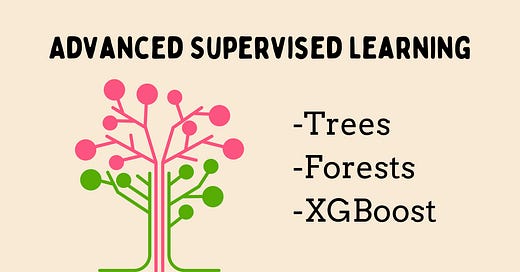Decision Trees, Random Forests, and XGBoost Explained: Supervised Learning for Real-World Problems
Learn how Decision Trees, Random Forests, and XGBoost work to solve complex machine learning problems like loan default prediction. Understand when and why to use these advanced models.
Welcome back nerds to our Machine Learning series. So far, we've built a solid starting point. We've learned all about basic models like linear regression and logistic regression, and we’ve gone over how to prepare data and set up pipelines — so we've covered a lot already.
But as you can probably imagine, real-life problems are rarely as simple as the examples we've looked at so far. Real-world data is messy, noisy, and full of complicated patterns that simple models can't always figure out.
That’s why today, we’re moving into more advanced supervised learning methods.
We're going to talk about Decision Trees, Random Forests, and Gradient Boosting — especially XGBoost, which is one of the most powerful tools out there for machine learning.
This is all apart of my Machine Learning series. While everyone else gets just a taste, premium readers get the whole feast! Don't miss out on the full experience!
To help make sense of it all, I’ll take you through a real-world case — predicting loan defaults. This is a huge deal in banking because if a model makes a bad prediction, it can cost a lot of money. Which is also why it’s such a popular scenario to run.
Think about working at a bank. Every day, people apply for loans, and your job is to build a machine learning model that helps decide who’s likely to pay back the loan and who might not. If the model gets it wrong, the bank loses money. But making the right call isn’t easy because people’s financial behavior can be hard to predict.
Whether or not someone pays back a loan depends on a bunch of things — like how much money they make, their credit score, if they have a steady job, their debt compared to income, and sometimes even stuff we don’t have data on.
Basic models like linear regression can give us a good place to start, but to really understand all the complex ways these factors work together, we need stronger tools — and that’s what we’re jumping into today.
If you haven’t subscribed to my premium content yet, you need to check it out. You unlock exclusive access to all of these articles and all the code that comes with them, so you can follow along!
Here is the roadmap for our Machine Learning series, I am the Machine. You should check it out as I have broken down what you can expect from this. Check out the roadmap here.
Plus, you’ll get access to so much more, like monthly Python projects, in-depth weekly articles, the '3 Randoms' series, and my complete archive!
👉 Thank you for allowing me to do work that I find meaningful. This is my full-time job so I hope you will support my work.
I spend a lot of my week on these articles, so if you find it valuable, consider joining premium. It really helps me keep going and lets me know you’re getting something out of my work!
If you’re already a premium reader, thank you from the bottom of my heart! You can leave feedback and recommend topics and projects at the bottom of all my articles.
👉 If you get value from this article, please help me out, leave it a ❤️, and share it with others who would enjoy this. Thank you so much!
Alight, time tom jump right into it guys, buckle up!
A Quick Recap: What We Learned So Far
Keep reading with a 7-day free trial
Subscribe to The Nerd Nook to keep reading this post and get 7 days of free access to the full post archives.





